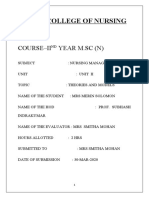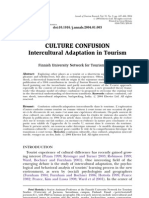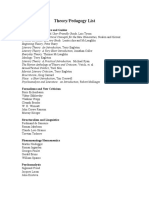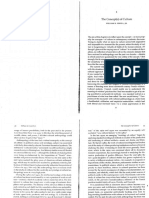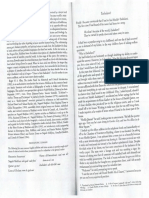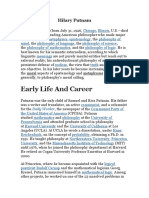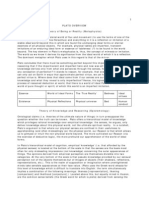Aesthetics - Kant
Aesthetics - Kant
Uploaded by
Matheus de BritoCopyright:
Available Formats
Aesthetics - Kant
Aesthetics - Kant
Uploaded by
Matheus de BritoOriginal Description:
Copyright
Available Formats
Share this document
Did you find this document useful?
Is this content inappropriate?
Copyright:
Available Formats
Aesthetics - Kant
Aesthetics - Kant
Uploaded by
Matheus de BritoCopyright:
Available Formats
Aesthetics - Kant
1 of 2
http://www.rowan.edu/open/philosop/clowney/aesthetics/philos_artist...
Immanuel Kant (1724-1804), German Enlightenment philosopher whose original and powerful philosophy
has shaped most subsequent western thought. He was a popular lecturer, and was capable of a lively,
readable style; although his major works are as dense and difficult as they are influential. (Kant defended
this as a deliberate choice, since he wanted to examine what could be known about the mind in itself, or a
priori, without depending on particular examples.)
Kant produced an early treatise on aesthetics, Observations on the Feeling of the Beautiful and Sublime
(1763), and did not write on the subject again until the end of his career, in the Critique of Judgment
(1790). In between the two works came the development of his influential critical philosophy. Although
Kant saw the Critique of Judgment as the key work which connected his writings on epistemology (the
theory of knowledge) in the Critique of Pure Reason with his writings on ethics in the Critique of
Practical Reason, it is not necessary to know these other works in order to understand the most influential
parts of Kant's aesthetics.
Like many other writers on aesthetics before him, Kant's main interest was not in art per se, but in Beauty
(and along with other eighteenth century writers, in the Sublime). Thus most of his remarks are as relevant
to the beautiful or sublime in nature as in art. Like other Enlightenment writers, (e.g, Hutcheson and
Hume), Kant also thought that Beauty or Sublimity were not really properties of objects, but ways in
which we respond to objects. (So they all wrote, not about the Form of the Beautiful, as Plato or a
medieval philosopher would have done, but about Taste.) And like these other writers, Kant was
concerned to show that this focus on the subjective aesthetic response did not make aesthetic value a
mere function of individual or personal taste.
Kant's way of working out these problems is what makes his aesthetics original and influential. He claimed
that judgments of taste are both subjective and universal. They are subjective, because they are
responses of pleasure, and do not essentially involve any claims about the properties of the object itself.
(What matters is not the picture I see; rather it is the pleasing effect of the picture on me.) On the other
hand, aesthetic judgments are universal and not merely personal. That's because in a crucial way they
must be disinterested. When I am appreciating a painting aesthetically, I am not thinking about how much
money it's worth, or whether it is a portrait of a family member, or even about who painted it, except in so
far as knowing the painter helps me see what's in the work. These non-aesthetic interests are extraneous
to my appreciation of the painting. Rather I am pleased by the painting just for what it is, apart from
anything I may get out of it. In fact I do not even take an ethical interest in the painting's subject (that is,
any ethical interest is separate from this disinterested pleasure I take in the painting). "Taste that requires
an added element of charm and emotion for its delight, not to speak of adopting this as the measure of its
approval, has not emerged from barbarism" (CJ 13).
Kant thought that for aesthetic judgements to be both subjective and universal, they had to be about form.
Beauty should be "a question merely of the form" (CJ 13). More specifically, the object being
contemplated (e.g., a work of art, or an actual landscape) must display a kind of undefined purposiveness,
such that it seems to be organized with a final purpose in mind, although it is not possible to say what that
purpose is. Thus a work of art, or a beautiful natural object, displays a kind of free play of forms,
consistent with the presence of a purpose to which we don't have access. So intent was Kant on
emphasising the formal properties of the objects of aesthetic attention that he was unwilling to include
color among the aesthetically relevant properties of an object. Color, in his view, is mere decoration;
design and composition are what really matter (CJ 14).To sum up this point about form in Kant's own
words: "A judgment of taste which is uninfluenced by charm or emotion (though these may be associated
with the delight in the beautiful), and whose determining ground, therefore, is simply finality of form, is a
pure judgment of taste."
Kant divided the kinds of aesthetic response into responses to the Beautiful and the Sublime. The one
represents a pleasure in order, harmony, delicacy and the like. The other is a response of awe before the
21/05/2014 11:33
Aesthetics - Kant
2 of 2
http://www.rowan.edu/open/philosop/clowney/aesthetics/philos_artist...
infinite or the overwhelming. While the beautiful presents the appearance of form, the sublime may often
seem formless. The pleasure it gives us derives from our awareness that there is something in us that
transcends the overwhelming power or infinity outside us.
Finally, Kant had things to say about genius. In short, he thought that genius has its own rules, and one
cannot dictate to it.
How Kant arrived at his conclusions is not easily shown; and it is no surprise that the philosophical
reasoning that grounds those conclusions did not follow them into the cultural mainstream. But the
conclusions themselves proved quite influential. His remarks on genius, and on purposiveness in art and
nature, had an impact on the development of Romantic aesthetics. Later, the idea of a disinterested
appreciation of form became a watchword for philosophers and critics like Clement Greenberg who
defended abstract art. In literary criticism, the New Criticism which focused on the text itself, and its
philosophical defense by Beardsley and Wimsatt, were similarly inspired.
back to top
21/05/2014 11:33
You might also like
- Goldman (1979) - What Is Justified BeliefDocument13 pagesGoldman (1979) - What Is Justified BeliefJuan Manuel100% (1)
- Lesson Plan Grade 5 Math-Demo Multiplying DecimalsDocument3 pagesLesson Plan Grade 5 Math-Demo Multiplying DecimalsJayson Agustin100% (13)
- The Compass DeRose Guide To Emotion WordsDocument8 pagesThe Compass DeRose Guide To Emotion WordsPranjyoti SaikiaNo ratings yet
- Quintilian, Institutio OratoriaDocument10 pagesQuintilian, Institutio OratoriaMatheus de BritoNo ratings yet
- 10.4324 9780203069134 PreviewpdfDocument58 pages10.4324 9780203069134 PreviewpdfLittlelamb666No ratings yet
- Schlereth Material Culture and Cultural ResearchDocument18 pagesSchlereth Material Culture and Cultural ResearchRohin GalhotraNo ratings yet
- Hip Hop As Subculture PDFDocument13 pagesHip Hop As Subculture PDFRoberto A. Mendieta VegaNo ratings yet
- Local Transcendence: Essays on Postmodern Historicism and the DatabaseFrom EverandLocal Transcendence: Essays on Postmodern Historicism and the DatabaseNo ratings yet
- English 3040 Notes Deconstruction HandoutDocument2 pagesEnglish 3040 Notes Deconstruction HandoutMatheus de BritoNo ratings yet
- Theories and Models of AdministrationDocument74 pagesTheories and Models of Administrationkrishnasree100% (5)
- Definition of Organizational BehaviourDocument10 pagesDefinition of Organizational BehaviourShilpa Thakur100% (2)
- Heidegger and The Phenomenological ReductionDocument11 pagesHeidegger and The Phenomenological ReductionDe LasuNo ratings yet
- Contemporary Theory Syllabus 2018Document9 pagesContemporary Theory Syllabus 2018guesstheguestNo ratings yet
- Aparicio Cultural StudiesDocument23 pagesAparicio Cultural StudiesKapu Tejiendo VidaNo ratings yet
- Cultural Studies: Lorraine Walsh CashmanDocument11 pagesCultural Studies: Lorraine Walsh CashmanElmehdi MayouNo ratings yet
- Unit Plan Final-3Document24 pagesUnit Plan Final-3api-666253970No ratings yet
- Translocal Style Communities: Hip Hop Youth As Cultural Theorists of Style, Language, and GlobalizationDocument25 pagesTranslocal Style Communities: Hip Hop Youth As Cultural Theorists of Style, Language, and GlobalizationDanica PerišićNo ratings yet
- HOW NEWNESS ENTERS The WORLD Postmodem Space Postcolonial Times and The Trials of Cultural Translation-BkltDocument12 pagesHOW NEWNESS ENTERS The WORLD Postmodem Space Postcolonial Times and The Trials of Cultural Translation-BkltAsis YuurNo ratings yet
- Florencia Mallon, 1992. Indian Communities, Political Cultures, and The State in Latin America, 1780-1990Document20 pagesFlorencia Mallon, 1992. Indian Communities, Political Cultures, and The State in Latin America, 1780-1990masheila1985No ratings yet
- Aurea - EFL Lesson PlanDocument3 pagesAurea - EFL Lesson PlanscintillamxNo ratings yet
- Cultural Studies SyllabusDocument5 pagesCultural Studies SyllabusJonathan Frank McMillanNo ratings yet
- Dark Romanticism LessonDocument6 pagesDark Romanticism Lessonapi-498941454No ratings yet
- Culture ConfusionDocument20 pagesCulture ConfusionnirmaljoyNo ratings yet
- Criticism and Culture - The Body in CultureDocument8 pagesCriticism and Culture - The Body in CultureEllen CamenovitsNo ratings yet
- 05 Mulvey, Laura - Visual Pleasure and Narrative CinemaDocument7 pages05 Mulvey, Laura - Visual Pleasure and Narrative CinemajawharaNo ratings yet
- Theory/Pedagogy List: Introductory Overviews and GuidesDocument4 pagesTheory/Pedagogy List: Introductory Overviews and GuidesfhelvieNo ratings yet
- The Stage of Modernity-MitchellDocument34 pagesThe Stage of Modernity-Mitchellmind.ashNo ratings yet
- Greenblatt - Cultural Mobility - IntromanifestoDocument28 pagesGreenblatt - Cultural Mobility - IntromanifestoEvelyn AmayaNo ratings yet
- Simmel - Categories of Human ExperienceDocument3 pagesSimmel - Categories of Human ExperienceMônica PernyNo ratings yet
- Anderson 2019Document10 pagesAnderson 2019Ratoe KidoelNo ratings yet
- Partha Chatterjee - Beyond The NationDocument6 pagesPartha Chatterjee - Beyond The NationMaya GurungNo ratings yet
- Jean-Paul Sartre S Notebooks For An EthiDocument13 pagesJean-Paul Sartre S Notebooks For An EthiTapu ManaNo ratings yet
- Settler Colonialism LessonDocument8 pagesSettler Colonialism Lessonapi-516766736No ratings yet
- Responding To Puritan PoetryDocument3 pagesResponding To Puritan PoetryLiz HackettNo ratings yet
- Caribbean Culture or MimicryDocument12 pagesCaribbean Culture or MimicrynibelulaNo ratings yet
- AFRI 598: Africa: Representation, Human Rights, and DevelopmentDocument11 pagesAFRI 598: Africa: Representation, Human Rights, and DevelopmentAbdirahmanNo ratings yet
- Yellow Wallpaper Lesson PlanDocument9 pagesYellow Wallpaper Lesson Planapi-641350551No ratings yet
- AR Zanger Hawthorne The Birthmark 106Document9 pagesAR Zanger Hawthorne The Birthmark 106Emma-Andreea ZaharcuNo ratings yet
- Stolcke - Talking Culture: New Boundaries, New Rhetorics of Exclusion in EuropeDocument25 pagesStolcke - Talking Culture: New Boundaries, New Rhetorics of Exclusion in EuropeRodolfo Rufián RotoNo ratings yet
- Literary Criticism LensesDocument11 pagesLiterary Criticism Lensesapi-292101337No ratings yet
- Sewellcompletoinglés PDFDocument14 pagesSewellcompletoinglés PDFJohnathan VargasNo ratings yet
- SSS Syllabus African HistoryDocument28 pagesSSS Syllabus African Historybestrukie30No ratings yet
- As Device: Notes On The Theory of Literature He SaysDocument8 pagesAs Device: Notes On The Theory of Literature He SaysRaphael ValenciaNo ratings yet
- Silvia Federici - Precarious LaborDocument8 pagesSilvia Federici - Precarious Labortamaradjordjevic01No ratings yet
- ZabalaawiDocument5 pagesZabalaawiEstefany Lopez0% (1)
- Cae - No AnswersDocument9 pagesCae - No AnswersFernando CeaNo ratings yet
- Unit FourDocument32 pagesUnit Fourapi-270008509No ratings yet
- The West and The RestDocument3 pagesThe West and The RestSarah LusackNo ratings yet
- Anderson - Imagined Communities (Print)Document58 pagesAnderson - Imagined Communities (Print)batman baleNo ratings yet
- Developing A Rhizomatic MethodologyDocument44 pagesDeveloping A Rhizomatic MethodologyGiorgio BertiniNo ratings yet
- Fredric Jameson - Ideology of The Text - The Ideologies of Theory IDocument28 pagesFredric Jameson - Ideology of The Text - The Ideologies of Theory IAmitabh Roy100% (1)
- Chapter 7 Realism and NaturalismDocument14 pagesChapter 7 Realism and NaturalismnoeliareaporcelNo ratings yet
- Davila - Culture PDFDocument4 pagesDavila - Culture PDFMónica A. RíosNo ratings yet
- Science Studies and The History of Science: Lorraine DastonDocument18 pagesScience Studies and The History of Science: Lorraine DastonGabita31100% (1)
- Cultural ViolenceDocument16 pagesCultural ViolenceGrupo Chaski / Stefan Kaspar100% (3)
- Gayatri Chakravorty Spivak: A Critical Study: ThesisDocument185 pagesGayatri Chakravorty Spivak: A Critical Study: ThesisJulia BanerjeeNo ratings yet
- Gayatri Spivak - Draupadi by Mahasveta DeviDocument23 pagesGayatri Spivak - Draupadi by Mahasveta DeviAnkita TanejaNo ratings yet
- Destructive Plasticity and The Living Dead Malabou ReadingFreudDocument14 pagesDestructive Plasticity and The Living Dead Malabou ReadingFreudmadequal2658No ratings yet
- Cultural Studies and The Centre: Some Problematics and Problems (Stuart Hall)Document11 pagesCultural Studies and The Centre: Some Problematics and Problems (Stuart Hall)Alexei GallardoNo ratings yet
- Early Life and Career: Hilary PutnamDocument14 pagesEarly Life and Career: Hilary PutnamDavidNo ratings yet
- Beaulieu Fall Unit Plan 11-15Document123 pagesBeaulieu Fall Unit Plan 11-15api-312799145No ratings yet
- History of Knowledge DastonDocument24 pagesHistory of Knowledge DastonARGHA MANNANo ratings yet
- Postmodern FictionDocument11 pagesPostmodern FictionHurmatMNo ratings yet
- CompleteCAE WLM ExtendedUnit03 PDFDocument2 pagesCompleteCAE WLM ExtendedUnit03 PDFMatheus de BritoNo ratings yet
- CompleteCAE WLM ExtendedUnit12 PDFDocument2 pagesCompleteCAE WLM ExtendedUnit12 PDFMatheus de BritoNo ratings yet
- Xword Part 1 Cover PDFDocument2 pagesXword Part 1 Cover PDFMatheus de BritoNo ratings yet
- CompleteCAE WLM ExtendedUnit04 PDFDocument2 pagesCompleteCAE WLM ExtendedUnit04 PDFMatheus de BritoNo ratings yet
- CompleteCAE WLM ExtendedUnit05 PDFDocument2 pagesCompleteCAE WLM ExtendedUnit05 PDFMatheus de BritoNo ratings yet
- Xword Cover Part 2 PDFDocument5 pagesXword Cover Part 2 PDFMatheus de BritoNo ratings yet
- Direction of FitDocument4 pagesDirection of FitMatheus de BritoNo ratings yet
- Plato Overview Theory of Being or Reality (Metaphysics) : Richard L. W. Clarke LITS2306 Notes 02CDocument6 pagesPlato Overview Theory of Being or Reality (Metaphysics) : Richard L. W. Clarke LITS2306 Notes 02CMatheus de BritoNo ratings yet
- Food Freezing GuideDocument40 pagesFood Freezing GuideindrasucahyoNo ratings yet
- Aesthetics and Poetry of The Fin-De-Siècle: Dr. Richard Clarke LITS3001 Notes 02ADocument2 pagesAesthetics and Poetry of The Fin-De-Siècle: Dr. Richard Clarke LITS3001 Notes 02AMatheus de BritoNo ratings yet
- German Idealism: Dr. Richard Clarke LITS2002 Notes 04ADocument1 pageGerman Idealism: Dr. Richard Clarke LITS2002 Notes 04AMatheus de BritoNo ratings yet
- Early Modern ThoughtDocument6 pagesEarly Modern ThoughtMatheus de BritoNo ratings yet
- There Is No God 2011Document317 pagesThere Is No God 2011Howard HillNo ratings yet
- Literary Devices - NotesDocument5 pagesLiterary Devices - NotesShamini MurallyNo ratings yet
- Team Element For GPDocument2 pagesTeam Element For GPwalterNo ratings yet
- Strength Ands Weaknesses of Using A Single Theory To CounsellingDocument11 pagesStrength Ands Weaknesses of Using A Single Theory To CounsellingJoseph Kihiu100% (1)
- BanglalinkDocument11 pagesBanglalinkMostafa Monsur AhmedNo ratings yet
- Persuasive Speaking: Chapter Objectives: Chapter OutlineDocument19 pagesPersuasive Speaking: Chapter Objectives: Chapter OutlinemistermooseNo ratings yet
- 12 Angry Men PDFDocument3 pages12 Angry Men PDF1-5 IX GimnazijaNo ratings yet
- DIVORCE and Family RelationsDocument51 pagesDIVORCE and Family Relationsvonito11No ratings yet
- Election LessonDocument5 pagesElection Lessonapi-255268125No ratings yet
- Differing Views of Single Parents in Raising Their ChildrenDocument64 pagesDiffering Views of Single Parents in Raising Their ChildrenMary CourtneyNo ratings yet
- Expectation WorksheetDocument4 pagesExpectation WorksheetMihaelaNo ratings yet
- Division of Bohol: Choose and Check The Appropriate Box/s BelowDocument1 pageDivision of Bohol: Choose and Check The Appropriate Box/s BelowKateNo ratings yet
- The Milgram ExperimentDocument7 pagesThe Milgram ExperimentJoshua CollinsNo ratings yet
- StudyFast SpeedReading Handbook 2018Document28 pagesStudyFast SpeedReading Handbook 2018raad XMaths100% (6)
- Impact of Organizational Culture On Organizational Performance: AnDocument12 pagesImpact of Organizational Culture On Organizational Performance: AnAndrea IlievskaNo ratings yet
- Car Ring Ton, Christopher. The Division of Domestic Labor in Lesbigay Families. No Place Like Home. Pp. 175-206Document32 pagesCar Ring Ton, Christopher. The Division of Domestic Labor in Lesbigay Families. No Place Like Home. Pp. 175-206musicma1n1No ratings yet
- Cognition Matlin 7th TBDocument22 pagesCognition Matlin 7th TBDevin Mckay100% (2)
- Masasi ProposalDocument27 pagesMasasi Proposalshepherd junior masasiNo ratings yet
- DoshiDocument64 pagesDoshiDivya maniNo ratings yet
- Mock 6 QDocument48 pagesMock 6 QRaman ChawlaNo ratings yet
- Team Coaching Methodologies: Facilitated By: Kathryn KempDocument19 pagesTeam Coaching Methodologies: Facilitated By: Kathryn Kemphilari_mateo1328No ratings yet
- How Science Fiction WorksDocument4 pagesHow Science Fiction WorkslucaslongoNo ratings yet
- Wj-Cog Presentation Most Recent Feb 13Document28 pagesWj-Cog Presentation Most Recent Feb 13api-258682603100% (1)
- Observation BRMDocument15 pagesObservation BRMArunAKumarNo ratings yet
- Reading and Thinking Strategies Across Text TypesDocument13 pagesReading and Thinking Strategies Across Text TypesJade AluarteNo ratings yet









